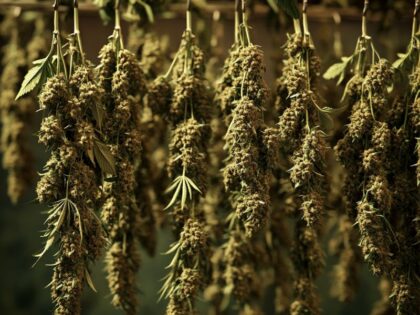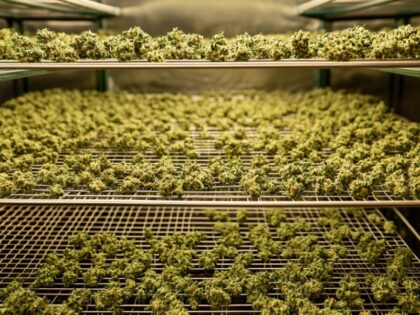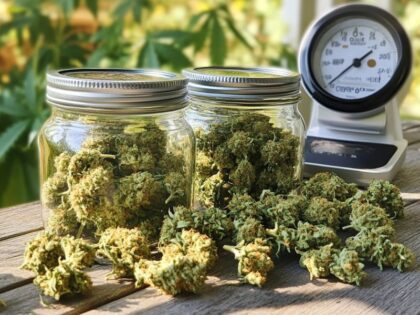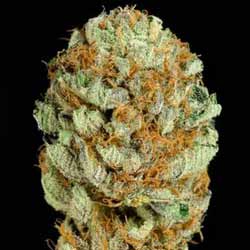How to Dry Weed: 2 Common Ways to Try At Home
Drying weed properly is a crucial step in cannabis cultivation that directly impacts the potency, flavor, and shelf life of your buds. Whether you’re a first-time grower or looking to improve your process, here are two common drying methods you can easily try at home.
Table of Contents
Why is Cannabis Drying Important?
Drying cannabis is essential to preserve its potency, flavor, and overall quality. Removing excess moisture from freshly harvested cannabis plants helps prevent mold, improves the burn, and prepares the buds for the curing process. Proper drying also ensures cannabinoids and terpenes remain intact, contributing to a smoother, more effective experience when consumed.
Hang Drying Vs Rack Drying Cannabis
|
Feature |
Hang Drying | Rack Drying |
|
Method |
Whole plant or branches are hung upside down |
Individual buds are spread out on mesh racks |
|
Air Circulation |
Natural air flow around hanging buds |
Requires well-ventilated space for even drying |
|
Drying Speed |
Slower drying process |
Typically dries faster |
|
Space Requirement |
Needs more vertical space (e.g., drying room) |
More compact; can stack multiple trays |
|
Handling |
Less frequent bud handling |
Requires more touch, which may affect trichomes |
|
Ideal For |
Larger buds or whole plant drying |
Popcorn buds and small buds |
|
Benefits |
Preserves bud shape and trichomes; more natural drying |
Efficient use of space; good for high-volume harvests |
| Common Use | Most growers prefer for higher-quality results |
Used when drying large quantities quickly |
How to Dry Weed
Drying weed is a critical step that affects the final quality, potency, and smoothness of your cannabis. Choosing the right drying method can help preserve essential cannabinoids and terpenes while reducing the risk of mold or over-drying.
Hang Drying

Hang drying is a traditional and widely used method for drying cannabis.
- Harvest and Trim – Cut branches or the whole plant after the flowering stage, removing large fan leaves to promote air flow.
- Hang Upside Down – Suspend the branches or plant in a dark room with controlled temperature and humidity (60–70°F and 50–60% relative humidity).
- Ensure Air Circulation – Use fans to maintain fresh air flow, but don’t blow directly on the buds.
- Monitor Drying – After 7–10 days, check if the smaller stems snap easily—this indicates the buds are dry enough to cure.
Rack Drying

Rack drying is a space-saving alternative that works well for smaller or trimmed buds.
- Trim and Separate – Wet trim buds and spread them evenly on a mesh drying rack.
- Use a Drying Room – Place racks in a dark room with consistent temperature and humidity control.
- Rotate and Check – Gently turn buds regularly to release moisture evenly and prevent flat spots.
- Watch for Dryness – In 5–7 days, check for dryness by feeling the buds and ensuring they are no longer moist to the touch.
How to Know When Cannabis is Dried Properly
Knowing when your cannabis is properly dried is essential to avoid mold, preserve potency, and prepare for curing. Here are a few signs to look for:
Snap Test
Try bending a small stem—if it snaps cleanly rather than bending, your buds are likely dry enough. Larger stems may still feel slightly flexible, which is okay.
Bud Texture
Properly dried buds feel dry to the touch but not brittle. The outer surface should be crisp while the inside retains a bit of sponginess.
Smell Check
The scent of fresh cannabis should change to a more pronounced, aromatic smell. If it still smells grassy or like chlorophyll, it may need more drying time.
Visual Appearance
Dry buds appear tight and slightly shrunken, with visible trichomes still intact. Sugar leaves may curl inward, and there should be no visible moisture or dark spots.
Weight and Feel
The buds should feel lighter and should not stick together. Wet buds or ones that feel heavy likely still contain too much moisture.
Final Thoughts

Drying cannabis the right way sets the foundation for great flavor, potency, and long-term storage. Whether you choose hang drying or rack drying, paying close attention to moisture levels, airflow, and temperature will help you produce high-quality buds ready for curing. Continue learning about the full post-harvest process to ensure your cannabis is properly cured and stored for long-term use.
Frequently Asked Questions
How long does it take to dry cannabis completely?
Drying cannabis typically takes 5 to 10 days, depending on the drying method, bud size, and environmental conditions. Hang drying whole branches may take closer to 7–10 days, while rack drying individual buds may finish in 5–7 days. Always check dryness by performing the stem snap test rather than relying solely on time.
Can I speed up the drying process with heat?
While it’s possible to dry buds faster using heat or a boiler room, it’s not recommended. Excess heat can degrade cannabinoids and terpenes, reducing flavor, aroma, and potency. A slower drying process at controlled temperatures (60–70°F) and humidity (50–60%) is ideal for preserving final quality.
Is it safe to dry cannabis in a closet?
Yes, a closet can work as a drying space if it’s dark, has good air circulation, and allows for proper temperature and humidity control. Be sure to avoid direct sunlight and use fans or a dehumidifier to prevent too much moisture buildup.
What’s the difference between dry and wet trimming?
Wet trimming is done immediately after harvest, while the buds still contain moisture. Dry trimming is performed after the buds have dried. Wet trimming is faster and helps buds dry quicker, while dry trimming often results in a smoother appearance and better preservation of trichomes.
Should I dry my cannabis with sugar leaves on or off?
Leaving sugar leaves on during drying can slow the process, which some growers prefer for preserving terpenes. However, trimming them off beforehand (wet trimming) allows for faster drying and reduces the chance of trapping moisture around the buds.
Can I use paper bags or paper towels for drying?
Paper bags or towels can be used in small-batch drying, especially for popcorn buds or if you’re trying to slow down drying in a too-dry environment. However, they require frequent monitoring and airflow to avoid trapping moisture and risking mold. They’re best used temporarily, not as a primary method.
Related Posts
What is a Marijuana Grow Tent? 6 Benefits and Usage Tips
Weed Plant Stages: 5 Steps Towards Great Buds
How to Dry Weed: 2 Common Ways to Try At Home
CATEGORIES
Best Selling Seeds











